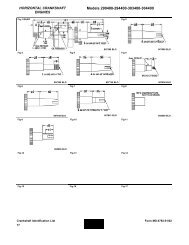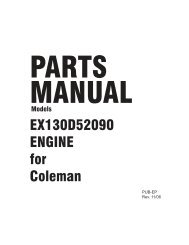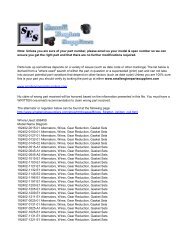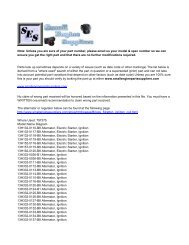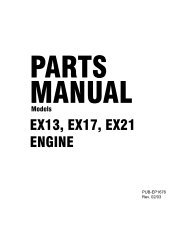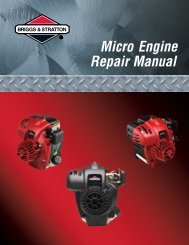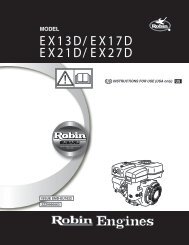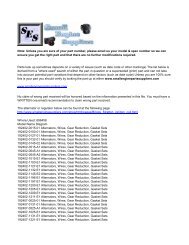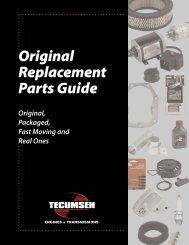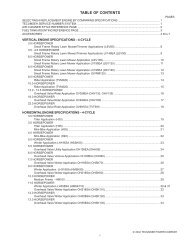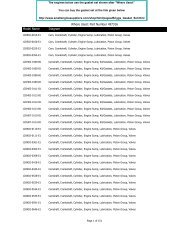TC/TM SERIES 2-Cycle Engines - Small Engine Suppliers
TC/TM SERIES 2-Cycle Engines - Small Engine Suppliers
TC/TM SERIES 2-Cycle Engines - Small Engine Suppliers
- No tags were found...
Create successful ePaper yourself
Turn your PDF publications into a flip-book with our unique Google optimized e-Paper software.
TESTINGENGINE KNOCKS1. Check the blade hub, adapter, crankshaft coupler or associated equipment for loose fit, or loose bolts. Re-install andre-torque the bolts to the proper torque.2. Check the flywheel key and the flywheel and crankshaft keyway for wear or partial shearing. Replace if any damageis evident. Tighten the flywheel nut to the proper torque.3. Check for the correct ignition module air gap. See Chapter 6 under "Service".4. Remove the muffler and check for carbon build-up in the combustion chamber and exhaust port. Check the sparkplug for the proper reach and heat range (correct spark plug for the engine). Clean carbon build-up if necessary.5. Check the internal components (piston, cylinder, and crankshaft journals) for excessive clearance.ENGINE OVERHEATS1. Make sure the engine is not being overloaded. Remove excess load.2. Make sure the fuel mixture contains the correct ratio of certified 2-cycle oil to gasoline. Replace the fuel supply ifquestionable.3. Check for clogged cooling fins or obstructions to the air flow. Remove the rewind assembly, clean and reinstall.4. Check the engine R.P.M. setting using a Vibratach or other tachometer and compare it to the R.P.M. settings foundon microfiche card # 30 or computer parts lookup according to the engine model and specification number. Adjustas necessary.5. Remove the muffler and check for carbon build-up in the combustion chamber and exhaust port. Clean asnecessary.6. Check the carburetor for the correct idle mixture adjustment. Clean the carburetor if the problem persists. SeeChapter 3 under "Service".7. Check for the correct ignition module air gap. See Chapter 6 under "Service".8. Inspect the intake gaskets, crankcase seals or gaskets for a leaking condition. Use a commercially availablecrankcase pressure tester and follow the tester's recommended test procedure. See "Disassembly Procedure" inthis chapter for component removal.SURGES OR RUNS UNEVENLY1. Check the fuel cap to make sure it is venting. Loosen the cap and retry engine operation.2. Replace or clean the air filter if applicable.3. Check the carburetor for the correct idle mixture adjustment. Clean the carburetor if the problem persists. SeeChapter 3 under "Service".4. Check the engine R.P.M. setting using a Vibratach or other tachometer and compare it to the R.P.M. settings foundon microfiche card # 30 or computer parts lookup according to the engine model and specification number. Adjustas necessary.5. Visually check all linkages. Check the governor spring for a stretched or damaged condition. Check the governorshaft, throttle shaft, and pivot points for binding.6. Check the ignition module operation using a Tecumseh 670366 Spark Tester inserted in the high tension lead.Check for intermittent spark.7. Inspect the intake gaskets, crankcase seals or gaskets for a leaking condition. Use a commercially availablecrankcase pressure tester and follow the tester's recommended test procedure. See "Disassembly Procedure" inthis chapter for component removal.ENGINE MISFIRES1. Check the spark plug for a fouled condition. Replace if questionable.2. Check the carburetor for the proper adjustments. See "Pre-sets and Adjustments". See Chapter 3 under "Service".3. Check the air gap dimension. Follow the procedure in Chapter 6 under "Service". Use an in-line spark tester to seeif the problem is ignition related.37



